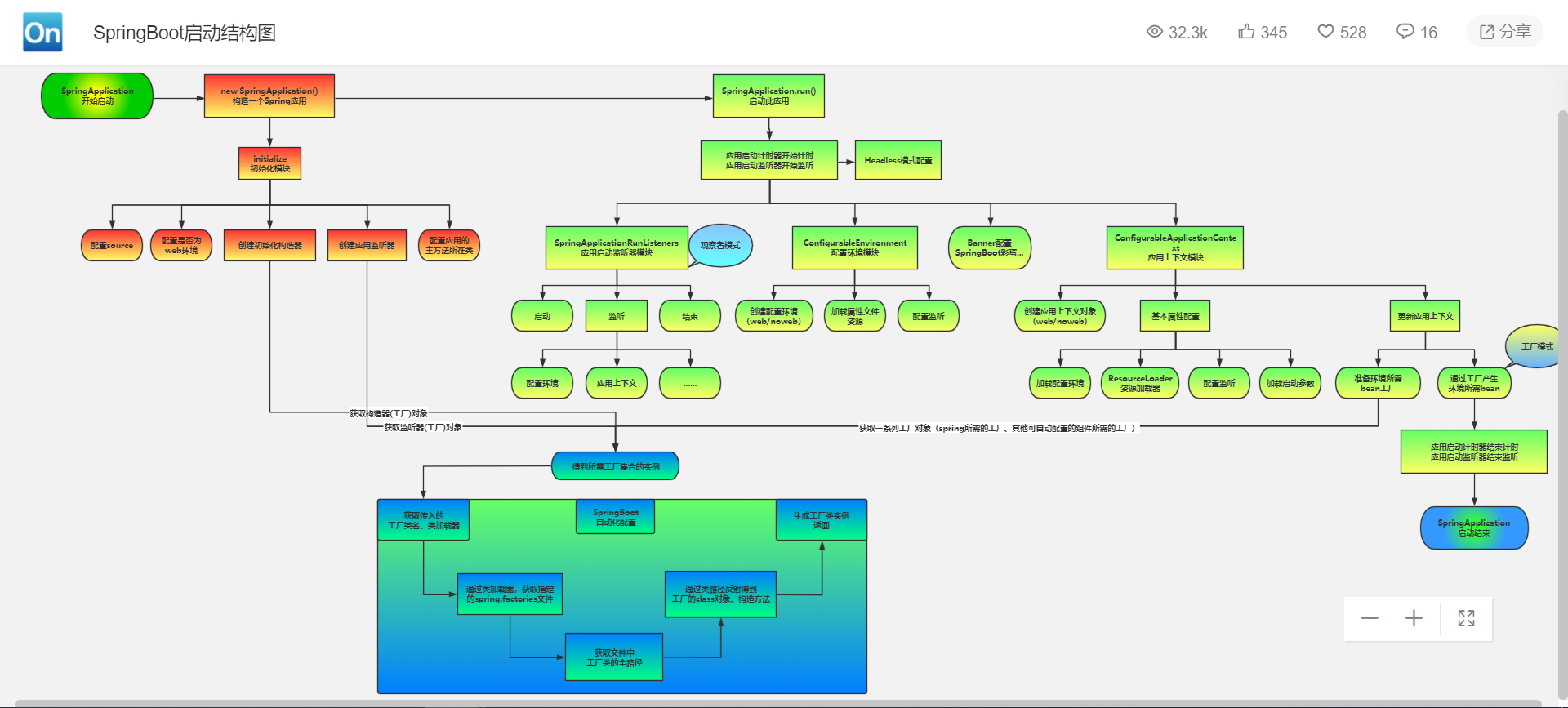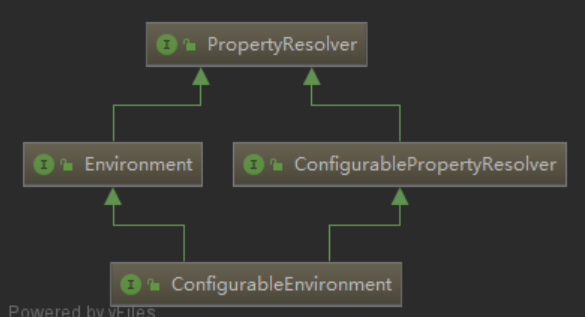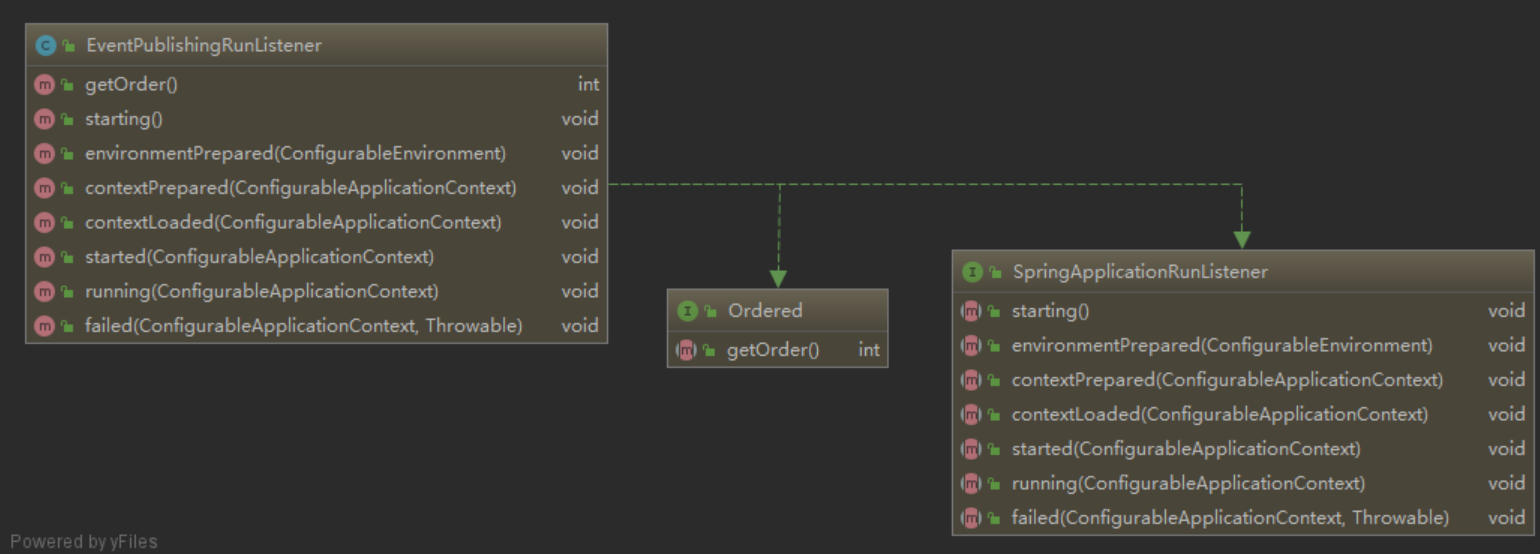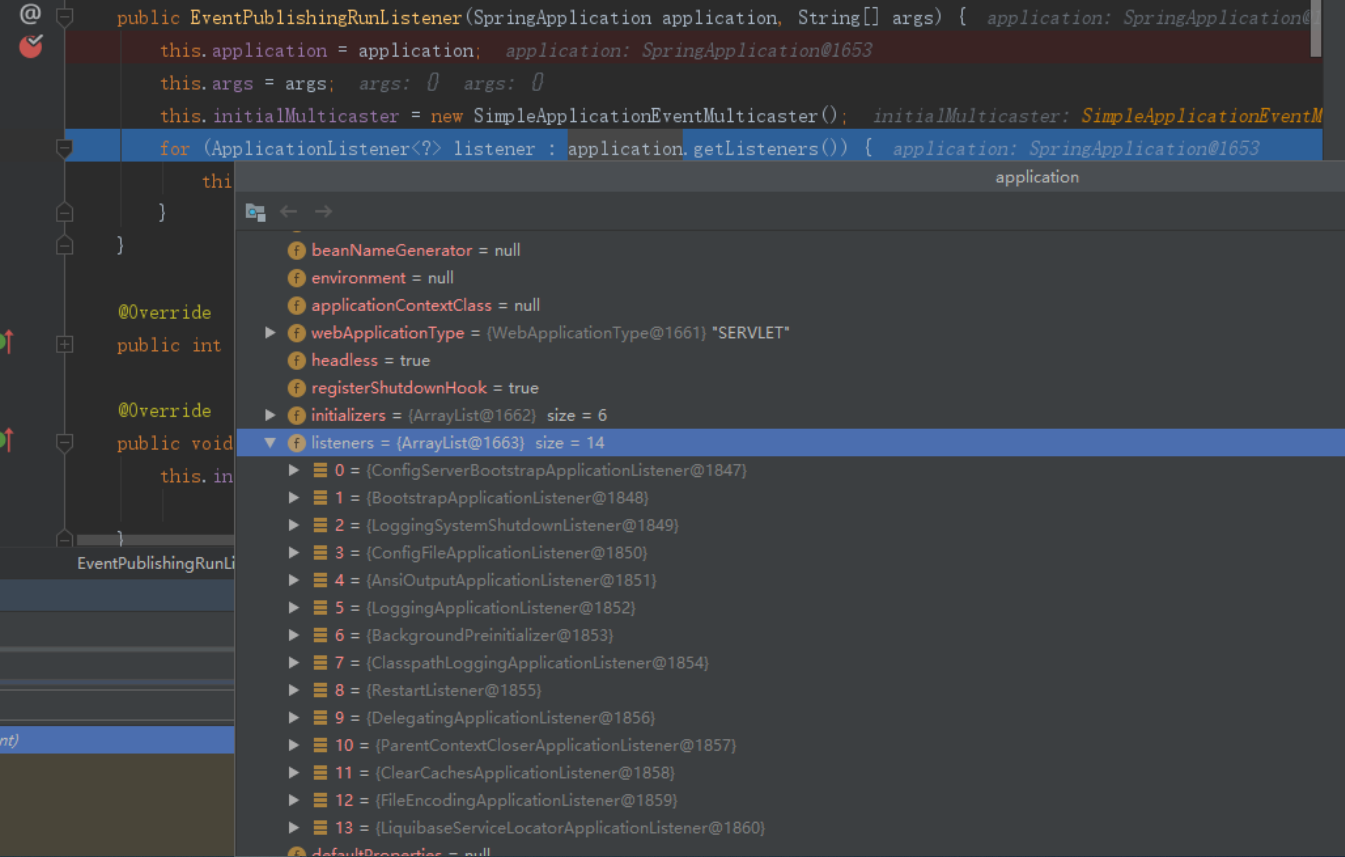
原图链接:https://www.processon.com/view/link/59812124e4b0de2518b32b6e
本文的分析基于Spring Boot 2.1.5,非Spring的代码只有下面这个启动main函数:
@SpringBootApplication
public class App {
public static void main(String[] args) {
SpringApplication application = new SpringApplication(AppServer.class);
application.run(args);
}
}
构造函数
SpringApplication的构造函数实例化了 初始化上下文的各种接口--ApplicationContextInitializer以及监听器--ApplicationListener,要注意的是这里的实例化,并不像平时的Spring Components一样通过注解和扫包完成,而是通过一种不依赖Spring上下文的加载方法,这样才能在Spring完成启动前做各种配置。Spring的解决方法是以接口的全限定名作为key,实现类的全限定名作为value记录在项目的META-INF/spring.factories文件中,然后通过SpringFactoriesLoader工具类提供静态方法进行类加载并缓存下来,spring.factories是Spring Boot的核心配置文件,后面会继续说明。另外比较有意思的是两个deduce方法,Spring Boot项目主要的目标之一就是自动化配置,通过这两个deduce方法可以看出,Spring Boot的判断方法之一是检查系统中是否存在的核心类。
public SpringApplication(ResourceLoader resourceLoader, Class<?>... primarySources) {
this.resourceLoader = resourceLoader;
Assert.notNull(primarySources, "PrimarySources must not be null");
this.primarySources = new LinkedHashSet<>(Arrays.asList(primarySources));
this.webApplicationType = WebApplicationType.deduceFromClasspath();//通过核心类判断是否开启、开启什么web容器
//实例化初始器
setInitializers((Collection) getSpringFactoriesInstances(ApplicationContextInitializer.class));
//实例化监听器
setListeners((Collection) getSpringFactoriesInstances(ApplicationListener.class));
this.mainApplicationClass = deduceMainApplicationClass();
}
Run
初始化完成之后就进到了run方法,run方法完成了所有Spring的整个启动过程:准备Environment——发布事件——创建上下文、bean——刷新上下文——结束,其中穿插了很多监听器的动作,并且很多逻辑都是靠各种监听器的实现类执行的,所以在分析run方法之前,先看下各种核心监听器、接口的作用。
ConfigurableApplicationContext

相对于只读的ApplicationContext而言,ConfigurableApplicationContext提供了配置上下文的接口,如设置Environment、监听器、切面类、关闭上下文的钩子等,还有刷新上下文的接口。默认是只读的接口,接口名前面加Configurable对应是一个提供可配置接口的新接口——在Spring很多配置相关的接口中都有这样的继承形式,例如ConfigurableEnvironment和Environment、ConfigurablePropertyResolver和PropertyResolver、ConfigurableBeanFactory和BeanFactory等等。
继承的三个父类接口里,Closeable提供了关闭时资源释放的接口,Lifecycle是提供对生命周期控制的接口(startstop)以及查询当前运行状态的接口,ApplicationContext则是配置上下文的中心配置接口,继承了其他很多配置接口,其本身提供查询诸如id、应用程序名等上下文档案信息的只读接口,以及构建自动装配bean的工厂(注释上官方说该接口提供的工厂是用于注册上下文外部的bean的,但调试发现和在程序内@Autowired获取到的工厂是同一个对象...)。简单写下ApplicationContext继承的父类接口。
- EnvironmentCapable
提供Environment接口。 - MessageSource
国际化资源接口。 - ApplicationEventPublisher
事件发布器。 - ResourcePatternResolver
资源加载器。 - HierarchicalBeanFactory、ListableBeanFactory
这两个都继承了bean容器的根接口BeanFactory
ConfigurableEnvironment
一般在写业务代码时使用的都是只读类型的接口Environment,该接口是对运行程序环境的抽象,是保存系统配置的中心,而在启动过程中使用的则是可编辑的ConfigurableEnvironment。接口的UML类图如下,提供了合并父环境、添加active profile以及一些设置解析配置文件方式的接口。
其中一个比较重要的方法MutablePropertySources getPropertySources();,该方法返回一个可编辑的PropertySources,如果有在启动阶段自定义环境的PropertySources的需求,就可以通过该方法设置。

EventPublishingRunListener

该监听器实际上是一个用于广播Spring事件的广播器,实现SpringApplicationRunListener接口的方法都是包装一个Spring事件并进行广播,例如:
@Override
public void contextPrepared(ConfigurableApplicationContext context) {
this.initialMulticaster.multicastEvent(new ApplicationContextInitializedEvent(this.application, this.args, context));
}
@Override
public void running(ConfigurableApplicationContext context) {
context.publishEvent(new ApplicationReadyEvent(this.application, this.args, context));
}
可以看到有两种广播方式,一种是当Spring还在启动的时候,通过监听器内部的SimpleApplicationEventMulticaster广播器进行广播;一种是当Spring启动完成内部的广播器可用时,直接调用上下文提供的接口进行广播。
继续分析Run
了解了一些核心的接口后,就可以启动Debug模式运行Run方法了,由于涉及的方法调用很多,以下代码将拆分源码,并将方法签名记在前面。
首先开启了一个秒表用来统计启动时间并在日志打印(如果开启控制字),声明了一些在后面需要用到的变量,然后开始初始化SpringApplicationRunListener类型的监听器,SpringApplicationRunListeners对监听器List进行了封装,例如调用.starting()时会遍历内部所有监听器调用其.starting()方法。
- 1.遍历SpringApplication初始化过程中加载的SpringApplicationRunListeners
- 2.调用Starting()监听SpringApplication的启动
- 3.加载SpringBoot配置环境(ConfigurableEnvironment)
- 4.设置banner属性
- 5.创建ConfigurableApplicationContext(应用配置上下文)
- 6.将listeners、environment、applicationArguments、bannner等重要组件与上下文对象关联
- 7.bean的实力化完成
/**
* Run the Spring application, creating and refreshing a new
* {@link ApplicationContext}.
* @param args the application arguments (usually passed from a Java main method)
* @return a running {@link ApplicationContext}
*/
public ConfigurableApplicationContext run(String... args) {
StopWatch stopWatch = new StopWatch();
stopWatch.start();
ConfigurableApplicationContext context = null;
Collection<SpringBootExceptionReporter> exceptionReporters = new ArrayList<>();
configureHeadlessProperty();
//1.遍历SpringApplication初始化过程中加载的SpringApplicationRunListeners
SpringApplicationRunListeners listeners = getRunListeners(args);
//2.调用starting()监听SpringApplication的启动
listeners.starting();
try {
ApplicationArguments applicationArguments = new DefaultApplicationArguments(args);
//3.加载SpringBoot配置环境
ConfigurableEnvironment environment = prepareEnvironment(listeners, applicationArguments);
configureIgnoreBeanInfo(environment);
//4.设置banner属性
Banner printedBanner = printBanner(environment);
//5.创建ConfigurableApplicationContext(应用配置上下文)
context = createApplicationContext();
exceptionReporters = getSpringFactoriesInstances(SpringBootExceptionReporter.class,
new Class[] { ConfigurableApplicationContext.class }, context);
//6.将listeners、environment、applicationArguments、banner等重要组件与上下文对象关联
prepareContext(context, environment, listeners, applicationArguments, printedBanner);
//7.实例化bean
refreshContext(context);
afterRefresh(context, applicationArguments);
stopWatch.stop();
if (this.logStartupInfo) {
new StartupInfoLogger(this.mainApplicationClass).logStarted(getApplicationLog(), stopWatch);
}
listeners.started(context);
callRunners(context, applicationArguments);
}
catch (Throwable ex) {
handleRunFailure(context, ex, exceptionReporters, listeners);
throw new IllegalStateException(ex);
}
try {
listeners.running(context);
}
catch (Throwable ex) {
handleRunFailure(context, ex, exceptionReporters, null);
throw new IllegalStateException(ex);
}
return context;
}
1.遍历SpringApplication初始化过程中加载的SpringApplicationRunListeners
private SpringApplicationRunListeners getRunListeners(String[] args) {
Class<?>[] types = new Class<?>[] { SpringApplication.class, String[].class };//SpringApplicationRunListener的构造函数参数类型
return new SpringApplicationRunListeners(logger, getSpringFactoriesInstances(SpringApplicationRunListener.class, types, this, args));
}
2.调用Starting()监听SpringApplication的启动
public void starting() {
//遍历所有的SpringApplicationRunListener,调用starting()方法监听SpringApplication的启动
for (SpringApplicationRunListener listener : this.listeners) {
listener.starting();
}
}
调试发现,注册为SpringApplicationRunListener的实现类只有EventPublishingRunListener,之前说过该注册器是一个用于广播Spring事件的广播器,进到构造函数中可以看到都有哪些监听器被绑定到了这个广播器中,这里每个监听器的作用就不再深入了,需要说的是,如果在项目中有什么需要集成到Spring的框架,可以注册SpringApplicationRunListenerApplicationListener的实现类,监听Spring的不同启动事件并执行集成的逻辑。当然也有别的方法,例如:Creating a Custom Starter with Spring Boot。

3.加载SpringBoot配置环境(ConfigurableEnvironment)
加载SpringBoot配置环境(configurableEnvironment),如果是通过web容器发布,会加载StandardEnvironment。将配置文件(Environment)加入到监听器对象中(SpringApplicationRunListeners)
private ConfigurableEnvironment prepareEnvironment(SpringApplicationRunListeners listeners,
ApplicationArguments applicationArguments) {
// Create and configure the environment
//如果environment不为空直接返回 || 如果是web环境则直接实例化StandardServletEnvironment类 || 如果不是web环境则直接实例化StandardEnvironment类
ConfigurableEnvironment environment = getOrCreateEnvironment();
//配置环境信息
configureEnvironment(environment, applicationArguments.getSourceArgs());
//通知所有的监听者,环境已经准备好了
listeners.environmentPrepared(environment);
bindToSpringApplication(environment);
if (!this.isCustomEnvironment) {
environment = new EnvironmentConverter(getClassLoader()).convertEnvironmentIfNecessary(environment,
deduceEnvironmentClass());
}
ConfigurationPropertySources.attach(environment);
return environment;
}
4.设置banner属性
private Banner printBanner(ConfigurableEnvironment environment) {
//如果未开启banner打印直接返回
if (this.bannerMode == Banner.Mode.OFF) {
return null;
}
//创建ResourceLoader对象
ResourceLoader resourceLoader = (this.resourceLoader != null) ? this.resourceLoader
: new DefaultResourceLoader(getClassLoader());
//创建SpringApplicationBannerPrinter,该对象用来打印banner
SpringApplicationBannerPrinter bannerPrinter = new SpringApplicationBannerPrinter(resourceLoader, this.banner);
//如果bannerMode模式为LOG,则将bannner打印到log文件中
if (this.bannerMode == Mode.LOG) {
return bannerPrinter.print(environment, this.mainApplicationClass, logger);
}
//打印banner到控制台
return bannerPrinter.print(environment, this.mainApplicationClass, System.out);
}
5.初始化ConfigurableApplicationContext(应用配置上下文)
public enum WebApplicationType {
/**
* The application should not run as a web application and should not start an
* embedded web server.
*/
// 应用程序不是web应用,也不应该用web服务器去启动
NONE,
/**
* The application should run as a servlet-based web application and should start an
* embedded servlet web server.
*/
//应用程序应作为基于servlet的web应用程序运行,并应启动嵌入式servlet web(tomcat)服务器
SERVLET,
/**
* The application should run as a reactive web application and should start an
* embedded reactive web server.
*/
//应用程序应作为 reactive web应用程序运行,并应启动嵌入式 reactive web服务器。
REACTIVE;
}
根据webEnvironment是否是web环境创建默认的contextClass,AnnotationConfigEnbeddedWebApplicationContext(通过扫描所有注解类来加载bean)和ConfigurableWebApplicationContext),最后通过BeanUtils实例化上下文对象,并返回。
/**
* Strategy method used to create the {@link ApplicationContext}. By default this
* method will respect any explicitly set application context or application context
* class before falling back to a suitable default.
* @return the application context (not yet refreshed)
* @see #setApplicationContextClass(Class)
*/
protected ConfigurableApplicationContext createApplicationContext() {
//根据webEnvironment是否是web环境创建默认的contextClass
Class<?> contextClass = this.applicationContextClass;
if (contextClass == null) {
try {
switch (this.webApplicationType) {
case SERVLET:
//AnnotationConfigServletWebServerApplicationContext
contextClass = Class.forName(DEFAULT_SERVLET_WEB_CONTEXT_CLASS);
break;
case REACTIVE:
//AnnotationConfigReactiveWebServerApplicationContext
contextClass = Class.forName(DEFAULT_REACTIVE_WEB_CONTEXT_CLASS);
break;
default:
//AnnotationConfigApplicationContext
contextClass = Class.forName(DEFAULT_CONTEXT_CLASS);
}
}
catch (ClassNotFoundException ex) {
throw new IllegalStateException(
"Unable create a default ApplicationContext, " + "please specify an ApplicationContextClass",
ex);
}
}
//BeanUtils实例化上下文对象
return (ConfigurableApplicationContext) BeanUtils.instantiateClass(contextClass);
}
6.将listeners、environment、applicationArguments、banner等重要组件与上下文对象关联
private void prepareContext(ConfigurableApplicationContext context, ConfigurableEnvironment environment,
SpringApplicationRunListeners listeners, ApplicationArguments applicationArguments, Banner printedBanner) {
//设置上下文的environment
context.setEnvironment(environment);
//应用上下文后处理
postProcessApplicationContext(context);
//在context refresh之前,对其应用ApplicationContextInitializer
applyInitializers(context);
//上下文准备
listeners.contextPrepared(context);
//打印启动日志和启动应用的profile
if (this.logStartupInfo) {
logStartupInfo(context.getParent() == null);
logStartupProfileInfo(context);
}
// Add boot specific singleton beans
ConfigurableListableBeanFactory beanFactory = context.getBeanFactory();
//向beanFactory注册单例bean:命令行参数bean
beanFactory.registerSingleton("springApplicationArguments", applicationArguments);
if (printedBanner != null) {
//向beanFactory注册单例bean:banner bean
beanFactory.registerSingleton("springBootBanner", printedBanner);
}
if (beanFactory instanceof DefaultListableBeanFactory) {
((DefaultListableBeanFactory) beanFactory)
.setAllowBeanDefinitionOverriding(this.allowBeanDefinitionOverriding);
}
// Load the sources
//获取SpringApplication的primarySources属性
Set<Object> sources = getAllSources();
Assert.notEmpty(sources, "Sources must not be empty");
//将bean加载到应用上下文
load(context, sources.toArray(new Object[0]));
//向上下文添加ApplicationListener,并广播ApplicationPreparedEvent事件
listeners.contextLoaded(context);
}
7.bean的实例化完成,刷新应用上下文
refreshContext(context);
...
public void refresh() throws BeansException, IllegalStateException {
synchronized (this.startupShutdownMonitor) {
//记录启动时间、状态,web容器初始化其property,复制listener
prepareRefresh();
//这里返回的是context的BeanFactory
ConfigurableListableBeanFactory beanFactory = obtainFreshBeanFactory();
//beanFactory注入一些标准组件,例如ApplicationContextAwareProcessor,ClassLoader等
prepareBeanFactory(beanFactory);
try {
//给实现类留的一个钩子,例如注入BeanPostProcessors,这里是个空方法
postProcessBeanFactory(beanFactory);
// 调用切面方法
invokeBeanFactoryPostProcessors(beanFactory);
// 注册切面bean
registerBeanPostProcessors(beanFactory);
// Initialize message source for this context.
initMessageSource();
// bean工厂注册一个key为applicationEventMulticaster的广播器
initApplicationEventMulticaster();
// 给实现类留的一钩子,可以执行其他refresh的工作,这里是个空方法
onRefresh();
// 将listener注册到广播器中
registerListeners();
// 实例化未实例化的bean
finishBeanFactoryInitialization(beanFactory);
// 清理缓存,注入DefaultLifecycleProcessor,发布ContextRefreshedEvent
finishRefresh();
}
catch (BeansException ex) {
if (logger.isWarnEnabled()) {
logger.warn("Exception encountered during context initialization - " +
"cancelling refresh attempt: " + ex);
}
// Destroy already created singletons to avoid dangling resources.
destroyBeans();
// Reset 'active' flag.
cancelRefresh(ex);
// Propagate exception to caller.
throw ex;
}
finally {
// Reset common introspection caches in Spring's core, since we
// might not ever need metadata for singleton beans anymore...
resetCommonCaches();
}
}
}
回到run方法,最后的逻辑就是发布启动完成的事件,并调用监听者的方法。
...
afterRefresh(context, applicationArguments);//给实现类留的钩子,这里是一个空方法。
stopWatch.stop();
if (this.logStartupInfo) {
new StartupInfoLogger(this.mainApplicationClass).logStarted(getApplicationLog(), stopWatch);
}
listeners.started(context);//发布ApplicationStartedEvent事件
callRunners(context, applicationArguments);
}
catch (Throwable ex) {
handleRunFailure(context, ex, exceptionReporters, listeners);
throw new IllegalStateException(ex);
}
try {
listeners.running(context);//发布ApplicationReadyEvent事件
}
catch (Throwable ex) {
handleRunFailure(context, ex, exceptionReporters, null);
throw new IllegalStateException(ex);
}
return context;
参考链接:https://www.cnblogs.com/theRhyme/p/11057233.html#_label5